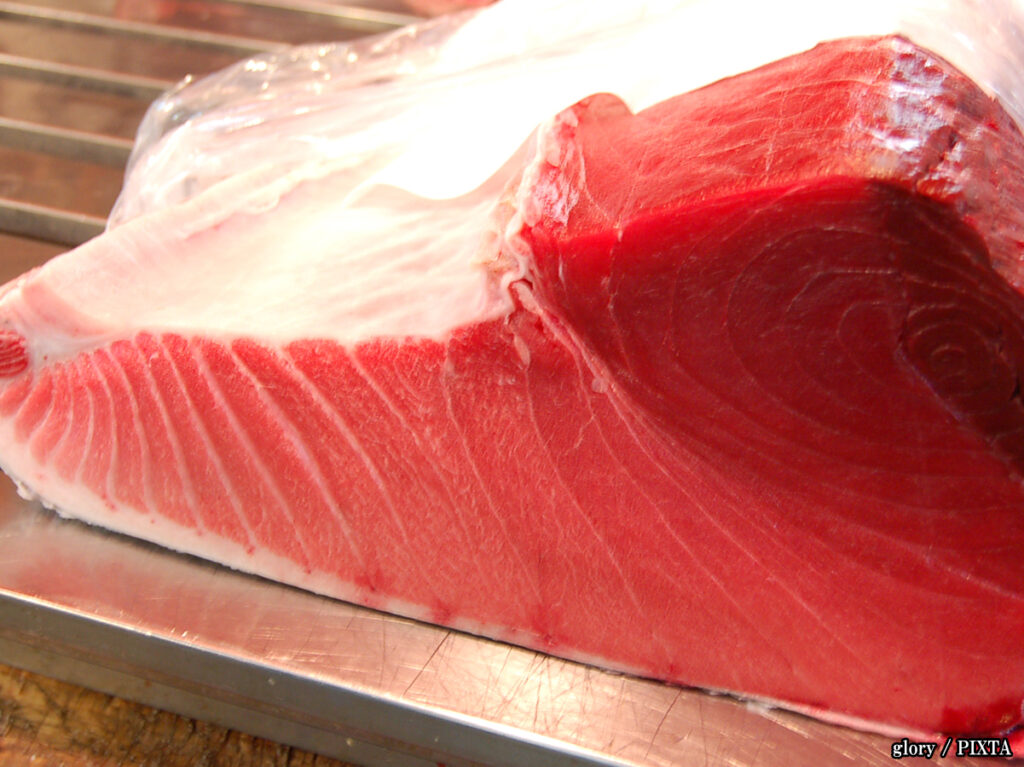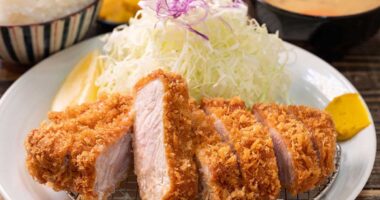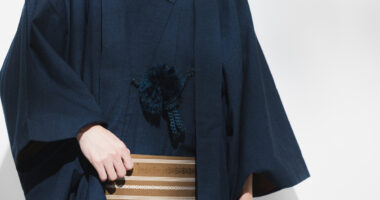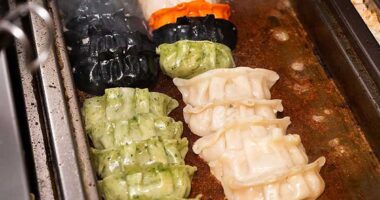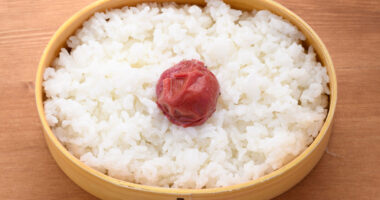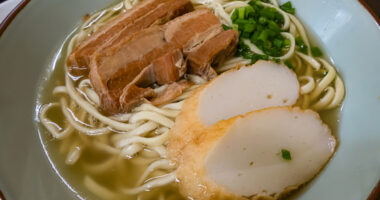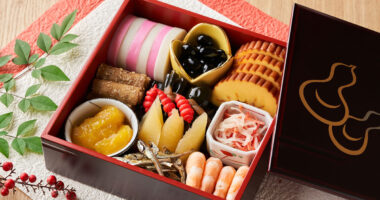- The journey of tuna in Japanese cuisine
- Hon-maguro (Pacific bluefin tuna): the king of tuna in Japan
- Mebachi-maguro (bigeye tuna): a bold and flavorful choice
- Kihada-maguro (yellowfin tuna): a lean option
- Binnaga-maguro (Albacore tuna): the delicate tuna
- Seasonal availability of tuna in Japan
- Final thoughts: Choosing the perfect tuna for your meal
Tuna, known as maguro in Japanese, is a staple in Japanese cuisine, enjoyed in sushi, sashimi, grilled dishes, and more. Japan is one of the largest consumers of tuna in the world, and different varieties are used depending on the dish and preparation method. Each type of tuna has unique flavors, textures, and fat content, making them suitable for different culinary applications. This guide explores the various tuna species found in Japan, their characteristics, historical significance, and how they are best enjoyed.
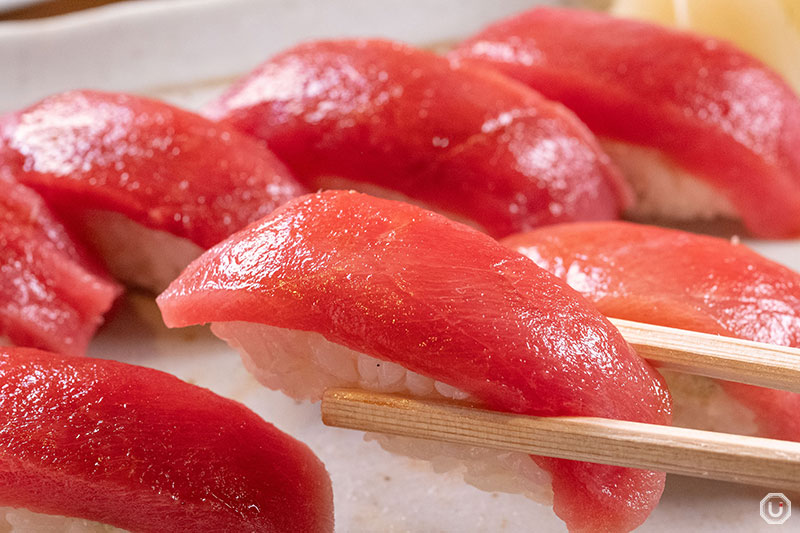
A plate of tasty tuna nigiri at Tsunesushi in Asakusa, Tokyo (photo for illustrative purposes)
The journey of tuna in Japanese cuisine
Tuna has long been a part of Japan’s culinary traditions, though its reputation has changed drastically over time. In the Edo period (1603-1868), it was far from the prized delicacy it is today. Back then, tuna was considered a commoner’s fish, often preserved in soy sauce to extend its shelf life rather than being enjoyed fresh.
Everything changed with advancements in refrigeration and the growing popularity of sushi in the 20th century. With better preservation methods, fresh tuna—especially the fatty, melt-in-your-mouth otoro—gained recognition as a luxury ingredient.
Today, Japan dominates the global tuna market, with top-grade fish fetching astonishing prices at auctions. In fact, the first tuna auction of the year at Tokyo’s Toyosu Market often makes headlines for record-breaking bids, reflecting just how deeply Japan treasures this fish.
Whether served as sashimi, grilled as a steak, or seared into a tataki, Tuna’s versatility keeps it at the heart of Japan’s culinary scene.
Hon-maguro (Pacific bluefin tuna): the king of tuna in Japan
Characteristics
Among all the tuna varieties enjoyed in Japan, hon-maguro (Pacific bluefin tuna) is regarded as the most luxurious and sought-after. This highly prized fish is known for its rich, buttery texture and deep red color, making it a staple in high-end sushi restaurants and fish markets.
The most desirable parts of this tuna come from its belly, where the fat content is highest. These include:
- Ōtoro: The fattiest and most tender part, known for its marbled texture and melt-in-the-mouth sensation.
- Chūtoro: A balance between lean and fatty, offering rich umami with a slightly firmer bite.
- Akami: The leanest part, deep red in color, with a clean, meaty flavor preferred by those who enjoy a less fatty taste.
Pacific bluefin tuna is mostly caught in the Pacific Ocean near Japan, with places like Ōma (Aomori Prefecture) and Nagasaki being well-known for their high-quality catches. The fish is so highly valued that the first auction of the year at Tokyo’s Toyosu Market often sees staggering prices, sometimes reaching millions of yen for a single fish.
Best cooking methods
Due to its exceptional texture and flavor, Pacific bluefin tuna is best enjoyed in ways that allow its natural richness to shine:
- Sushi and sashimi: The most common and revered way to eat bluefin tuna. Served raw, its deep umami flavors and buttery texture are best appreciated without excessive seasoning.
- Seared tataki: Lightly searing the exterior, a style known in Japanese as tataki, enhances its natural umami while retaining the tender texture inside. Tataki is traditionally associated with katsuo (skipjack), but is now commonly applied to tuna as well. This method is especially popular with chutoro, which has the perfect fat balance for a lightly charred crust.
- Grilled tuna steak: When cooked, bluefin tuna takes on a hearty, meaty texture similar to beef. Grilling a thick cut and seasoning it with soy sauce, garlic butter, or yuzu ponzu (a traditional condiment blending yuzu juice, vinegar, and other seasonings) elevates its savory depth.
Recipe: Bluefin Tuna Sashimi
- A simple yet elegant way to enjoy hon-maguro at home.
Ingredients
- 200 g (7.1 oz) fresh hon-maguro, sliced thinly
- 1 tbsp soy sauce
- 1 tsp wasabi
Instructions
- Arrange the tuna slices neatly on a plate.
- Prepare soy sauce and wasabi in separate small dishes.
- Dip each slice into the soy sauce, seasoned with wasabi if desired, and savor the rich umami of the fish.
Tip
For an authentic experience, serve with green shiso leaves, daikon radish cut sengiri style (sliced super-thin then cut into strings), and, if you can find it, freshly grated wasabi instead of the standard store-bought paste.
Where to find bluefin tuna in Japan
Bluefin tuna is a staple in Japan’s premium sushi culture, and the best places to find it include:
- Toyosu Fish Market and Tsukiji Outer Market (Tokyo): The best places to buy top-quality fresh cuts, and, at Toyosu, witness Pacific bluefin tuna auctions.
- High-end sushi restaurants in major cities: A reliable way of enjoying carefully sourced hon-maguro.
- Famous fishing towns like Oma: Known for some of the finest and most expensive bluefin tuna in Japan, often featured in high-end auctions.
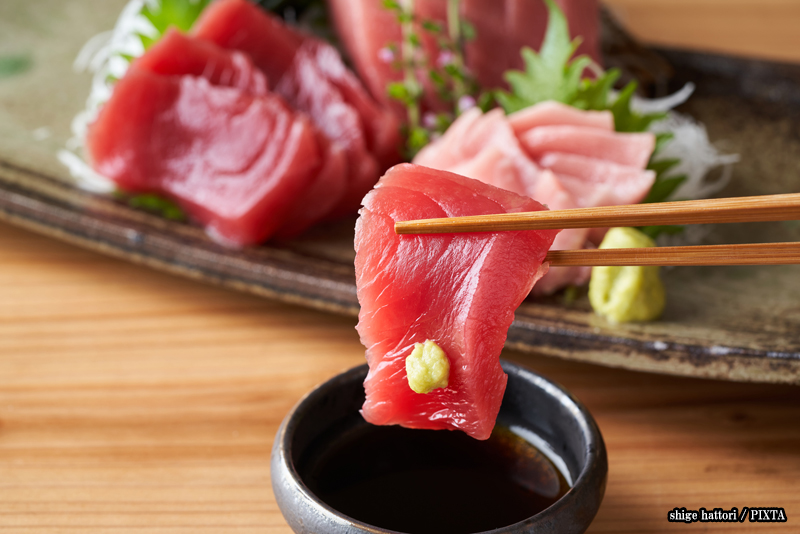
Photo for illustrative purposes
Mebachi-maguro (bigeye tuna): a bold and flavorful choice
Characteristics
Mebachi-maguro (bigeye tuna) features lean, mildly flavored red meat with a firm, meaty texture, and is widely used in various types of Japanese cuisine. While it shares a deep red color with bluefin tuna, it is generally less fatty, making it an ideal choice for those who prefer a cleaner, firmer bite in their sushi or cooked dishes.
This tuna variety is commonly found in warmer waters, especially around Okinawa and southern Japan. Since it has larger eyes (hence the name “bigeye”) and thrives in deeper waters, its meat develops a richer taste, making it versatile for various cooking methods.
It is also more affordable than bluefin tuna, making it a popular choice in supermarkets, fish markets, and conveyor belt sushi restaurants.
Best cooking methods
Since mebachi-maguro has a firmer texture with a bold umami taste, it is well-suited for a variety of preparations:
- Sushi and sashimi: Its deep red color and firmer texture make it a great option for those who enjoy a leaner sushi choice.
- Tuna tartare: The mild, meaty flavor of bigeye tuna pairs beautifully with ingredients like soy sauce, avocado, and sesame oil, creating opportunities for delicate yet flavorful tartare preparations.
- Grilled or broiled: Unlike fattier tuna varieties, bigeye tuna holds up well to grilling, making it an excellent choice for a lightly charred tuna steak or teriyaki-style preparation.
Recipe: Bigeye Tuna Tartare
A refreshing and flavorful way to enjoy mebachi-maguro, this dish is perfect as an appetizer or light meal.
Ingredients
- 150 g (5.3 oz) fresh bigeye tuna, finely diced
- 1 tsp sesame oil
- ½ tsp soy sauce
- 1 avocado, diced
- 1 tsp lime juice
Instructions
- In a bowl, gently mix the diced bigeye tuna, avocado, sesame oil, soy sauce, and lime juice.
- Serve with crispy seaweed sheets or crackers for a satisfying crunch.
- Enjoy immediately for the freshest flavor.
Tip
Add finely chopped scallions, a sprinkle of shichimi (Japanese seven-spice blend), or toasted sesame seeds for extra depth.
Where to find mebachi-maguro in Japan
Bigeye tuna is more widely available than premium Pacific bluefin tuna and can be found in various locations:
- Supermarkets and fish markets: Many Japanese supermarkets sell fresh mebachi-maguro in sashimi-grade cuts, making it easy to prepare at home.
- Sushi chains: Sushi chains in Japan frequently serve bigeye tuna nigiri and sashimi at affordable prices.
- Okinawa and southern Japan: Since bigeye tuna thrives in warmer waters, coastal markets in Kyushu, Shikoku, and Okinawa often have the freshest selections.
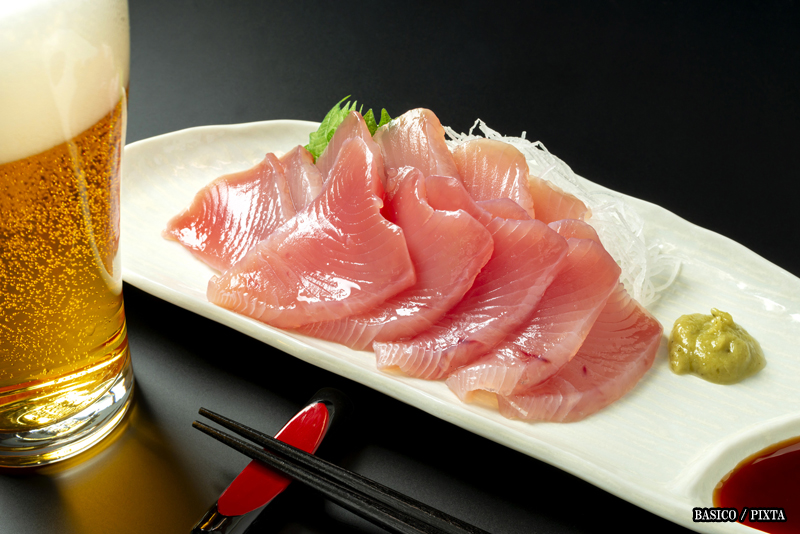
Photo for illustrative purposes
Kihada-maguro (yellowfin tuna): a lean option
Characteristics
Yellowfin tuna, known as kihada-maguro in Japan, is easily recognizable by its lighter red color and leaner texture compared to bluefin or bigeye tuna. Its mild flavor and firm flesh make it an incredibly versatile choice, suitable for both raw and cooked preparations.
One of its key characteristics is its low fat content. Unlike bluefin tuna, which is prized for its rich, buttery texture, yellowfin has a cleaner taste and firmer bite, making it perfect for grilled dishes, poke bowls, and even canned tuna preparations.
Yellowfin tuna is widely available in Japan due to its high population in tropical and subtropical waters. The country imports large quantities, and it is commonly found in supermarkets, izakayas, and restaurants serving casual seafood dishes.
Best cooking methods
Since kihada-maguro is lean and firm, it holds up well to various cooking styles, making it a favorite among chefs and home cooks alike.
- Grilled and seared: Yellowfin tuna develops a great crust when seared or grilled, making it an ideal choice for steaks, skewers, or tataki-style preparations.
- Tuna rice bowls and poke bowls: Yellowfin tuna is commonly used in rice bowls, known as maguro don. It’s also great in poke, a dish influenced by Hawaiian-Japanese cuisine. The mild flavor absorbs seasonings well, making it a perfect match for soy sauce, sesame oil, and citrus-based dressings.
- Canned tuna dishes: Yellowfin is one of the most popular choices for canned tuna in Japan. It is commonly used in onigiri (rice balls), salads, sandwiches, and pasta dishes.
Recipe: Seared Yellowfin Tuna with Ponzu Sauce
A simple yet elegant way to enjoy Kihada-maguro, this dish enhances the tuna’s natural freshness with a citrusy ponzu sauce.
Ingredients
- 200 g (7.1 oz) yellowfin tuna steak
- 2 tbsp ponzu sauce (citrus soy sauce)
- 1 tbsp sesame seeds
- 1 tsp vegetable oil
Instructions
- Heat vegetable oil in a pan over high heat.
- Place the yellowfin tuna steak in the pan and sear for 30 seconds on each side, ensuring the center remains rare.
- Remove from heat and let it rest for a minute. Slice thinly.
- Drizzle with ponzu sauce and sprinkle with toasted sesame seeds before serving.
Tip
Serve alongside sengii daikon and green shiso leaves for an authentic Japanese touch!
Where to find yellowfin tuna in Japan
Yellowfin tuna is widely available throughout Japan, making it one of the easiest tuna varieties to find.
- Supermarkets and fish markets: Most supermarkets sell kihada-maguro in sashimi-grade cuts, making it a convenient option for home cooking.
- Izakaya (Japanese gastropubs): Many izakayas serve grilled or seared yellowfin tuna, often paired with ponzu sauce, soy glaze, or miso marinades.
- Okinawa and Shikoku regions: Since yellowfin tuna thrives in warmer waters, coastal areas like Okinawa and Shikoku are known for their fresh kihada dishes, often served raw or grilled.
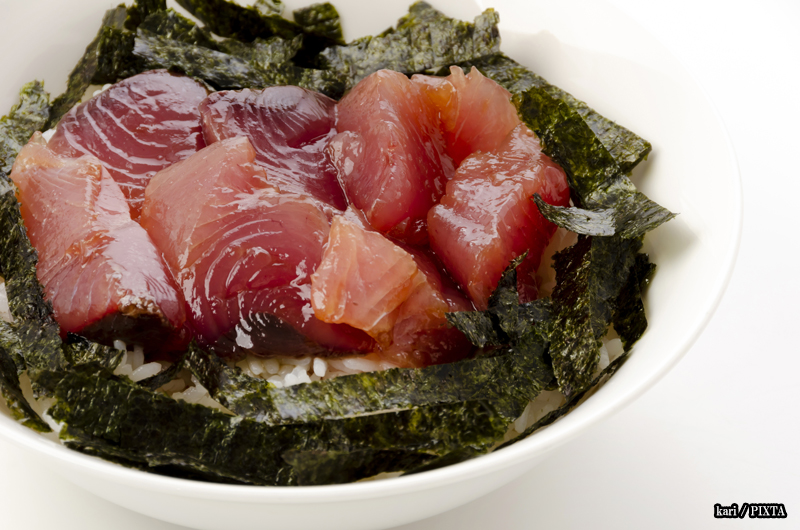
Photo for illustrative purposes
Binnaga-maguro (Albacore tuna): the delicate tuna
Characteristics
Albacore tuna, known as binnaga-maguro in Japan, stands out from other tuna varieties due to its light pinkish-white flesh and softer, almost buttery texture. Binnaga tuna has a pale, delicate color, which sets it apart from the deep red hues of bluefin and yellowfin tuna.
Its mild, slightly sweet taste makes it a great choice for those who find the rich flavors of bluefin or bigeye tuna a bit too intense. With its softer texture, albacore is often used in processed forms, such as canned tuna, smoked fillets, or sushi rolls.
While it might not be as prestigious as bluefin, albacore tuna is widely consumed in Japan due to its affordable price, accessibility, and versatility in cooking. It is a staple in Japanese households, especially for quick and easy meals like onigiri (rice balls) and pasta dishes.
Best cooking methods
Since albacore is softer and milder than other tuna varieties, it works best in recipes where it can absorb flavors and enhance the overall dish. Here are some of the best ways to enjoy binnaga-maguro.
- Canned tuna dishes: Albacore tuna is commonly canned and used in sandwiches, pasta, and salads. It absorbs seasonings well, making it perfect for dishes that require a creamy or flavorful base.
- Tuna salad and onigiri: In Japan, canned albacore mixed with mayonnaise and soy sauce is a classic filling for onigiri. The creamy texture pairs well with the soft rice and crispy nori.
- Grilled or pan-seared: While not as fatty as bluefin or bigeye, albacore holds up well to grilling or pan-searing. The heat adds a subtle smokiness that enhances its mild flavor.
Recipe: Japanese Tuna Onigiri
The combination of seasoned tuna, fluffy rice, and crispy seaweed makes tuna onigiri a perfect grab-and-go meal option.
Ingredients
- 1 cup cooked Japanese rice (short-grain or sushi rice)
- 1 small can of albacore tuna, drained
- 1 tbsp Japanese mayonnaise (Kewpie recommended)
- ½ tsp soy sauce
- 1 sheet of nori seaweed (laver), cut into strips
Instructions
- In a small bowl, mix drained albacore tuna with mayonnaise and soy sauce until well combined.
- Wet your hands slightly to prevent rice from sticking. Take a scoop of warm rice and flatten it in your palm.
- Place a small spoonful of the tuna mixture in the center and carefully mold the rice around it, forming a triangle or ball shape.
- Wrap with a strip of nori, pressing gently so it sticks to the rice.
- Serve immediately or wrap in plastic for an easy, portable meal!
Tip
You can add sesame seeds or finely chopped green onions to the tuna mix for extra flavor!
Where to find albacore tuna in Japan
Since albacore is commonly used in processed foods, it is easily accessible throughout Japan.
- Bento shops: Many shops selling bento (single-serving packed meals) include tuna-mayo onigiri in their daily selections, making it a convenient and affordable meal option.
- Casual sushi chains: Some kaitenzushi (conveyor belt sushi) restaurants serve binnaga sushi, often slightly seared to bring out its delicate flavors.
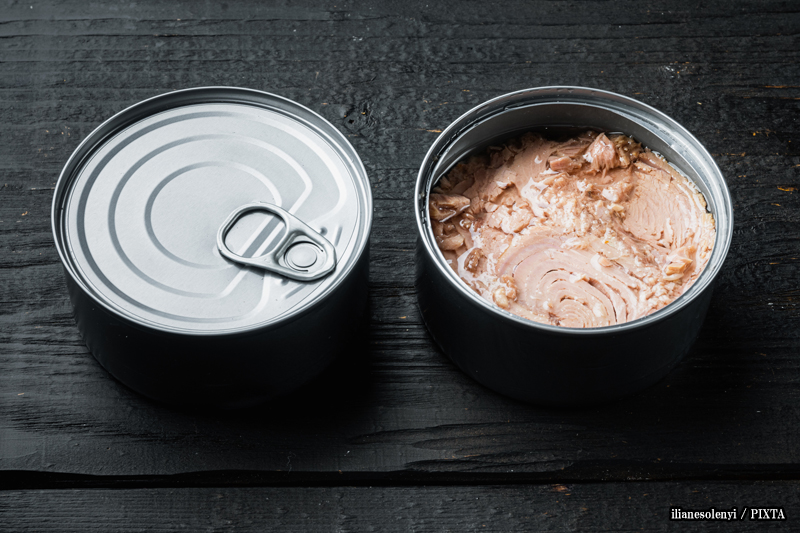
Photo for illustrative purposes
Seasonal availability of tuna in Japan
The best time to enjoy each type of tuna varies.
- Bluefin tuna: Winter is the best season when the fat content is highest.
- Bigeye tuna: Available year-round but bigeye caught near Japan has tow peak seasons, one from fall to winter, and another one in spring.
- Yellowfin tuna: Summer and fall are the best seasons.
- Albacore tuna: Available year-round but in season from spring to summer.
Final thoughts: Choosing the perfect tuna for your meal
The next time you visit Japan or dine at a Japanese restaurant, take a moment to explore the different types of maguro available. Experiment with new preparations, savor the nuances of each cut and enjoy the culinary journey that tuna has to offer.
